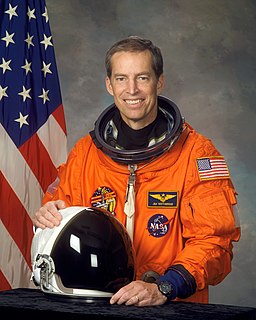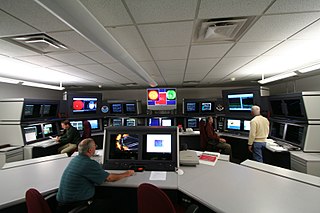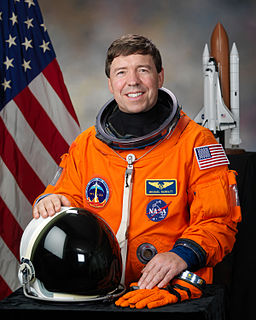Related Research Articles

Space tourism is human space travel for recreational purposes. There are several different types of space tourism, including orbital, suborbital and lunar space tourism. To date, orbital space tourism has been performed only by Roscosmos. Work also continues towards developing suborbital space tourism vehicles. This is being done by aerospace companies like Blue Origin and Virgin Galactic. In addition, SpaceX announced in 2018 that they are planning on sending space tourists, including Yusaku Maezawa, on a free-return trajectory around the Moon on the Starship.

The Lyndon B. Johnson Space Center (JSC) is NASA's center for human spaceflight, where human spaceflight training, research, and flight control are conducted. It was built and leased to NASA by Joseph L. Smith & Associates, Inc. It was renamed in honor of the late US president and Texas native, Lyndon B. Johnson, by an act of the United States Senate on February 19, 1973.

Fred Wallace Haise Jr. is an American former NASA astronaut, engineer, fighter pilot with the U.S. Marine Corps and U.S. Air Force, and a test pilot. He is one of only 24 people to have flown to the Moon, having flown as Lunar Module Pilot on Apollo 13. He was to have been the sixth person to land and walk on the Moon, but the Apollo 13 mission was aborted before lunar landing.

Robert Laurel Crippen is an American retired naval officer and aviator, test pilot, aerospace engineer, and retired astronaut. He traveled into space four times: as Pilot of STS-1 in April 1981, the first Space Shuttle mission; and as Commander of STS-7 in June 1983, STS-41-C in April 1984, and STS-41-G in October 1984. He was also a part of the Manned Orbiting Laboratory, Skylab Medical Experiment Altitude Test, Apollo–Soyuz, and the Approach and Landing Tests for the Space Shuttle. He did not go to space for any of those programs.

James Donald "Wxb" Wetherbee, is a retired United States Navy officer and aviator, test pilot, aerospace engineer, and NASA astronaut. He is a veteran of six Space Shuttle missions and is the only American to have commanded five spaceflight missions.

Joe Henry Engle is an American pilot, aeronautical engineer and former NASA astronaut. He was the commander of two Space Shuttle missions including STS-2 in 1981, the program's second orbital flight. He also flew three flights in the Shuttle program's 1977 Approach and Landing Tests. Engle is one of twelve pilots who flew the North American X-15, an experimental spaceplane jointly operated by the Air Force and NASA.

Vance DeVoe Brand is an American former naval officer and aviator, aeronautical engineer, test pilot, and NASA astronaut. He served as command module pilot during the first U.S.-Soviet joint spaceflight in 1975, and as commander of three Space Shuttle missions.

Patrick Graham Forrester is a retired United States Army officer, Army aviator and a NASA astronaut. At the time of his retirement from the U.S. Army, Forrester had achieved the rank of colonel. He is married and has two children.

The Space Weather Prediction Center (SWPC), named the Space Environment Center (SEC) until 2007, is a laboratory and service center of the US National Weather Service (NWS), part of the National Oceanic and Atmospheric Administration (NOAA), located in Boulder, Colorado. SWPC continually monitors and forecasts Earth's space environment, providing solar-terrestrial information. SWPC is the official source of space weather alerts and warnings for the United States.

Douglas Harry "Wheels" Wheelock is an American engineer and astronaut. He has flown in space twice, logging 178 days on the Space Shuttle, International Space Station, and Russian Soyuz. On July 12, 2011, Wheelock announced that he would be returning to active duty with the United States Army in support of Operation Enduring Freedom. He is currently working with NASA to test the Orion spacecraft at the Glenn Research Center in Plum Brook, Ohio.

A tropical cyclone forecast model is a computer program that uses meteorological data to forecast aspects of the future state of tropical cyclones. There are three types of models: statistical, dynamical, or combined statistical-dynamic. Ddual forecast model. Both consensus and superensemble forecasts can use the guidance of global and regional models runs to improve the performance more than any of their respective components. Techniques used at the Joint Typhoon Warning Center indicate that superensemble forecasts are a very powerful tool for track forecasting.

Space Center Houston is a science museum which serves as the official visitor center of NASA Johnson Space Center in Houston. It earned a place as a Smithsonian Affiliate museum in 2014. The organization is owned by NASA and operated under a contract by the nonprofit Manned Spaceflight Education Foundation, a 501(c)(3) organization. The Johnson Space Center is the home of Mission Control and astronaut training.

Gregory Carl "Ray J" Johnson, , is a former American naval officer and aviator, test pilot, aerospace engineer, and NASA astronaut. He spent his military career in both, the United States Navy and the Navy Reserve. Johnson was the Pilot on Space Shuttle mission STS-125, the final Hubble Space Telescope servicing mission.

Michael Reed Barratt is an American physician and a NASA astronaut. Specializing in aerospace medicine, he served as a flight surgeon for NASA before his selection as an astronaut, and has played a role in developing NASA's space medicine programs for both the Shuttle-Mir Program and International Space Station. His first spaceflight was a long-duration mission to the International Space Station, as a Flight Engineer in the Expedition 19 and 20 crew. In March 2011, Barratt completed his second spaceflight as a crew member of STS-133.
Joseph G. Galway, was an American meteorologist pioneering in the fields of severe convective storm forecasting and research. He was one of the first forecasters for the Severe Local Storms Unit and the National Severe Storms Forecast Center, and developed widely used synoptic predictors associated with severe thunderstorms and tornadoes, such as the jet streak and lifted index.
MesoWest is an ongoing cooperative project, started in 1996, to provide access to current and archive weather observations across the United States. Weather observations include but are not limited to: temperature, humidity, wind speed, wind direction, and precipitation. Data are collected from a variety of organizations. Some stations participate in voluntary weather observing networks such as the Citizen Weather Observer Program. Others are part of mesonets that are managed by private firms or federal/state/local agencies. These data are available for a multitude of uses. Over 20,000 weather stations actively report to the MesoWest database.

45th Weather Squadron, 45th Operations Group, 45th Space Wing, at Patrick Space Force Base, Florida performs weather assessments for air and space operations; specifically, weather observations, forecasts, advisories, and warnings. It specialized in the weather assessments for the Space Shuttle launches at Kennedy Space Center (KSC) and Cape Canaveral Space Force Station.

James Milton Heflin Jr. is a retired NASA official, who recently served as the associate director for technical activities at Johnson Space Center in Houston. Heflin also served as lead flight director for seven high-profile Space Shuttle missions, including the first to service and repair the Hubble Space Telescope and three that deployed inter-planetary probes.

Weather reconnaissance is the acquisition of weather data used for research and planning. Typically the term reconnaissance refers to observing weather from the air, as opposed to the ground.

Robert E. "Rob" Meyerson is an American aerospace engineer and executive known for his role in the development of reusable rocket launch systems.[1]
References
- ↑ "SMG and Space Program Mission, History, and Information". Spaceflight Meteorology Group. 3 Oct 2011. Retrieved 2012-01-24.
- ↑ "Frequently Asked Questions". Spaceflight Meteorology Group. 8 Oct 2002. Retrieved 2012-01-24.
- ↑ Brody, Frank C.; R.A. Lafosse; D.G. Bellue; T.D. Oram (Sep 1997). "Operations of the National Weather Service Spaceflight Meteorology Group". Weather Forecast. 12 (3): 526–44. Bibcode:1997WtFor..12..526B. doi:10.1175/1520-0434(1997)012<0526:OOTNWS>2.0.CO;2. ISSN 1520-0434.
- ↑ Oram, Timothy (Jan 2008). "NWS Spaceflight Meteorology Group Support for the NASA Constellation Orion Vehicle". 13th Conference on Aviation, Range and Aerospace Meteorology. New Orleans, LA: American Meteorological Society.
- ↑ "Spaceflight Meteorology Group Forecasters To Face Bold New Challenges". National Weather Service. 2011-08-15. Retrieved 2012-01-16.
- ↑ Oram, T.D. (May 2002). "Verification of world-wide space station emergency landing forecasts - Challenges and results" (PDF). 10th Conference on Aviation, Range, and Aerospace Meteorology. Portland, OR: American Meteorological Society. pp. 186–8.